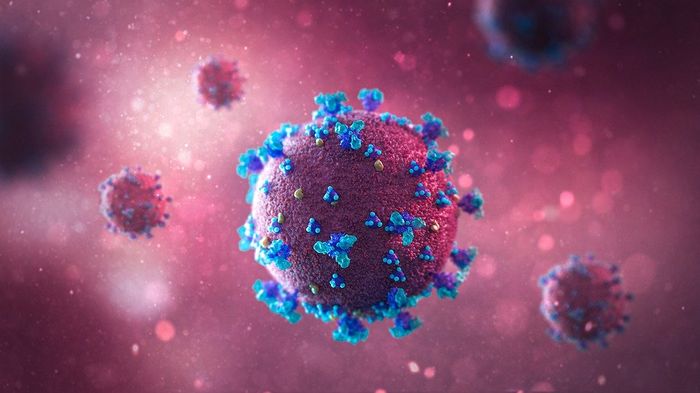Coronavirus is mutating – should we be worried?
Rachel Ibbott discusses the negative and surprisingly positive impacts of coronavirus mutations, and considers the impact these could have on the race to find a vaccine.
Development of a vaccination could be the solution to the COVID-19 pandemic. However, September’s rollercoaster of vaccine news has failed to acknowledge a potentially major barrier: mutation. SARS-CoV-2’s genome is already changing, possibly wreaking havoc on the precarious task of returning to normality.

Mutations are often seen as drastic, perhaps owing to their randomness, or to their superhuman portrayal in popular culture (such as the X-men). In fact, most have no effect on an organism, though others could confer evolutionary advantages – for a virus, this may mean boosting transmission and infection. Scientists have been continually monitoring viral genomes since the start of the pandemic, uploaded onto databases such as GISAID, COG-UK, and Nextstrain. But are coronavirus mutations really frequent or drastic enough to derail pandemic exit strategies?
Genetic mutations can alter protein shape and therefore viral properties. Of concern are increasing mutations in the nucleocapsid protein and 3a ciroporins, which enable new viruses to be released from an infected cell and transmit the virus to other cells. Another example is the D614G mutation, a single-base amino acid substitution from aspartate (D) to glycine (G) at position 614 in the coronavirus spike protein (which controls virus entry into human cells). This mutation spread across the world as the pandemic worsened, perhaps even aiding spread to Europe, quickly becoming ubiquitous. Patients with the D614G mutation have higher viral loads, and the mutated virus has higher infectious titres in the lab. Tentative evidence from population genetic modelling indicates that the mutation could have contributed to high infection rates in the UK. Luckily, multiple studies have reassured that D614G-mutated COVID-19 does not increase the severity of symptoms, though they might differ in how they present. The spike protein is additionally of importance for several vaccine trials, being deemed one of the most important targets for antibodies. Whilst the D614G mutation is not directly in the antibody binding domain, any further mutations in this domain would render several key vaccine trials useless.
These all sound like significant causes for alarm. Luckily, it seems that the coronavirus mutates more slowly than other dangerous viruses such as influenza. Even when mutations do arise, evolutionary theory predicts that most will be short-lived. Furthermore, common mutations such as D614G might not be caused by evolutionary advantage as many have feared. If a new cluster of cases was seeded by only a few viruses, any mutations present are replicated by default, not necessarily because they help transmission – this is known as the founder effect. Furthermore, mutations aren’t necessarily on the increase as SARS-CoV-2 adapts to its new human hosts – the same study concerned about mutations in nucleocapsid proteins found that the protein nsp12 is becoming more stable as the pandemic goes on, making it a good potential target for new drug candidates such as Remdesivir. Research from University College London has identified several other unchanging regions of the genome which may also prove useful.
[Knowledge of mutation patterns] could inform policy and control measures, such as distinguishing between the need for local or more widespread lockdowns in the coming autumn.
Mutations could even actively help us to control the pandemic. Analysis of different mutations in different genomes has the power to trace outbreaks back to their source. For example, the open source bank of sequences ‘Nextstrain’ provides analysis of subtypes of coronavirus emerging in different geographical locations – their August analysis displayed the contrast between mini-clusters in Europe (mostly local and within-country transmission) with various genetic mixtures in the US (lots of interstate transmission). This knowledge could inform policy and control measures, such as distinguishing between the need for local or more widespread lockdowns in the coming autumn.
More good news comes from researchers in Pennsylvania, USA, finding that the D614G mutated virus is more susceptible to antibody neutralisation – far from being a mutation enhancing escape from the immune response! Vaccines to the spike protein aim to elicit a specific immune response towards the virus, with the production of memory cells that will be on hand to quickly respond if the spike protein is encountered again. D614G spike proteins are better at attracting antibodies, meaning that the efficacy of vaccines currently being developed will likely be even greater against mutated forms of the virus.
So how worried about mutations should we be? While there is evidence that they could be both a threat and an aid, it’s important to recognise how little we know about the virus – our knowledge is shifting all the time. Early interpretations of data and sampling biases mean that conclusions from studies should be treated tentatively. Scientists globally are preparing for anything the pandemic can throw at us – careful monitoring of mutations over the next few years will be hugely important to spot signs of drug or vaccine resistance once these technologies are in use.
 News / SU stops offering student discounts8 January 2026
News / SU stops offering student discounts8 January 2026 News / Uni-linked firms rank among Cambridgeshire’s largest7 January 2026
News / Uni-linked firms rank among Cambridgeshire’s largest7 January 2026 Comment / Plastic pubs: the problem with Cambridge alehouses 5 January 2026
Comment / Plastic pubs: the problem with Cambridge alehouses 5 January 2026 News / New movement ‘Cambridge is Chopped’ launched to fight against hate crime7 January 2026
News / New movement ‘Cambridge is Chopped’ launched to fight against hate crime7 January 2026 Comment / What happened to men at Cambridge?31 December 2025
Comment / What happened to men at Cambridge?31 December 2025









